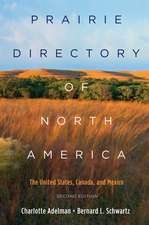Aquatic Ecosystems: Interactivity of Dissolved Organic Matter: Aquatic Ecology
Stuart Findlay, Robert L. Sinsabaughen Limba Engleză Hardback – 5 noi 2002
- There are many ways to study DOM and this book focuses on several central questions: How much DOM is there in a particular aquatic ecosytem? Where does it come from? Does the composition of the DOM vary from time to time and place to palce?
- How does DOM become incorporated into microbial food webs, which are the basis of plant, invertebrate and vertebrate food webs?
- How can the answers to these and other questions about DOM be considered together so that a better understanding of the significance of DOM can emerge?
Preț: 891.83 lei
Preț vechi: 1221.68 lei
-27% Nou
Puncte Express: 1338
Preț estimativ în valută:
170.65€ • 177.82$ • 141.30£
170.65€ • 177.82$ • 141.30£
Carte tipărită la comandă
Livrare economică 03-17 aprilie
Preluare comenzi: 021 569.72.76
Specificații
ISBN-13: 9780122563713
ISBN-10: 0122563719
Pagini: 512
Dimensiuni: 152 x 229 x 26 mm
Greutate: 0.84 kg
Editura: ELSEVIER SCIENCE
Seria Aquatic Ecology
ISBN-10: 0122563719
Pagini: 512
Dimensiuni: 152 x 229 x 26 mm
Greutate: 0.84 kg
Editura: ELSEVIER SCIENCE
Seria Aquatic Ecology
Public țintă
Aquatic ecologists, freshwater biologists, limnologists, hydrologists, water quality specialists, and graduate students interested in aquatic ecosystems.Cuprins
Section I: Sources and Composition
Supply of DOM to Aquatic Ecosystems: Autochthonous Sources.
Sources, Production and Regulation of Allochthonous Dissolved Organic Matter Inputs to Surface Waters.
Trace Organic Moieties of Dissolved Organic Material in Natural Waters.
The Role of Monomers in Stream Ecosystem Metabolism.
Molecular Indicators of the Bioavailability of Dissolved Organic Matter.
Large-Scale Patterns in DOC Concentration, Flux, and Sources.
The Speciation of Hydrophobic Organic Compounds by Dissolved Organic Matter.
Elemental Complexation by Dissolved Organic Matter in Lakes: Implications for Fe Speciation and the Bioavailability of Fe and P.
Section II: Transformation and Regulation
The Contribution of Monomers and Other Low Molecular Weight Compounds to the Flux of DOM in Aquatic Ecosystems.
Photochemically-Mediated Linkages Between Dissolved Organic Matter and Bacterioplankton.
The Importance of Organic Nitrogen Production in Aquatic Systems: A Landscape Perspective.
The Role of Biofilms in the Uptake and Transformation of Dissolved Organic Matter.
Microbial Extracellular Enzymes and Their Role in DOM Cycling.
Linkages between DOM Composition and Bacterial Community Structure.
Bacterial Response to Variation in Dissolved Organic Matter.
Section III: Approaches to Synthesis
Physiological Models in the Context of Microbial Food Webs.
Patterns in DOM Iability and Consumption across Aquatic Systems.
Integrating DOM Metabolism and Microbial Diversity: An Overview of Conceptual Models.
Dissolved Organic Carbon: Detrital Energetics, Metabolic Regulators, and Drivers of Ecosystem Stability of Aquatic Ecosystems.
Synthesis.
Supply of DOM to Aquatic Ecosystems: Autochthonous Sources.
Sources, Production and Regulation of Allochthonous Dissolved Organic Matter Inputs to Surface Waters.
Trace Organic Moieties of Dissolved Organic Material in Natural Waters.
The Role of Monomers in Stream Ecosystem Metabolism.
Molecular Indicators of the Bioavailability of Dissolved Organic Matter.
Large-Scale Patterns in DOC Concentration, Flux, and Sources.
The Speciation of Hydrophobic Organic Compounds by Dissolved Organic Matter.
Elemental Complexation by Dissolved Organic Matter in Lakes: Implications for Fe Speciation and the Bioavailability of Fe and P.
Section II: Transformation and Regulation
The Contribution of Monomers and Other Low Molecular Weight Compounds to the Flux of DOM in Aquatic Ecosystems.
Photochemically-Mediated Linkages Between Dissolved Organic Matter and Bacterioplankton.
The Importance of Organic Nitrogen Production in Aquatic Systems: A Landscape Perspective.
The Role of Biofilms in the Uptake and Transformation of Dissolved Organic Matter.
Microbial Extracellular Enzymes and Their Role in DOM Cycling.
Linkages between DOM Composition and Bacterial Community Structure.
Bacterial Response to Variation in Dissolved Organic Matter.
Section III: Approaches to Synthesis
Physiological Models in the Context of Microbial Food Webs.
Patterns in DOM Iability and Consumption across Aquatic Systems.
Integrating DOM Metabolism and Microbial Diversity: An Overview of Conceptual Models.
Dissolved Organic Carbon: Detrital Energetics, Metabolic Regulators, and Drivers of Ecosystem Stability of Aquatic Ecosystems.
Synthesis.
Recenzii
"This book is a must have for researchers and graduate students who wish to be more familiar with DOM cycling...The editors have done an excellent job of gathering together a group of DOM experts and compiling their expertise into a book whose worth extends beyond DOM research...provides a wealth of information that is nicely organized, condensed, and critically examined." --E.F. Benfield, Department of Biology, Virginia Tech, September 2004
"...is well structured, easy to understand, and has a reasonable amount of well-illustrated graphics...these features make the book suitable not only for specialists working in the field, but also for 'beginners,' graduate students, or those who simply want to learn more about the complex world of DOM...is an important contribution to the existing body of literature on DOM...highly recommended to anyone interested in DOM and suggest it as a valuable selection for university libraries." --JOURNAL OF EXPERIMENTAL MARINE BIOLOGY AND ECOLOGY, July 2003
"...this book is ideal for researchers and upper level students (MSc/PhD) who wish to be more familiar with the freshwater 'side' of DOM cycling." --EGU NEWSLETTER, 2003
"...is well structured, easy to understand, and has a reasonable amount of well-illustrated graphics...these features make the book suitable not only for specialists working in the field, but also for 'beginners,' graduate students, or those who simply want to learn more about the complex world of DOM...is an important contribution to the existing body of literature on DOM...highly recommended to anyone interested in DOM and suggest it as a valuable selection for university libraries." --JOURNAL OF EXPERIMENTAL MARINE BIOLOGY AND ECOLOGY, July 2003
"...this book is ideal for researchers and upper level students (MSc/PhD) who wish to be more familiar with the freshwater 'side' of DOM cycling." --EGU NEWSLETTER, 2003














